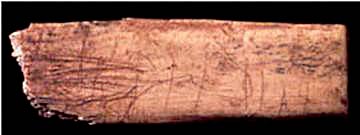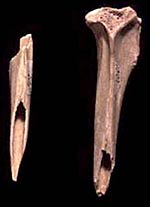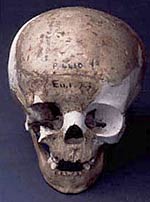
Artefactual
Archaeologists and palaeontologists have realised the potential of the caves at Creswell Crags for holding the story of man and the environment from the beginnings of archaeology in the middle to late 1800s. The names of those who have excavated there stretch to a dozen or more and include many professors and learned gentlemen and ladies. The details are excellently given on the webpages of the Creswell Heritage Trust www.creswell-crags.org.uk/virtuallytheiceage/Discover%20the%20past/index.html and www.creswell-crags.org.uk/virtuallytheiceage/Exploring_objects/Explore%20who.htm.
The excavated artefacts produced by earlier people and the bones of animals of interest to palaeontologists from the early excavations found their way to many museums. In those days smaller museums collected and exhibited what was of interest to the local people. Nowadays collecting is by the geographical area around each museum. Also this distribution of finds would never happen now as museum codes of practice insist on material from one site being kept together for the convenience of research. But in those days material of this kind was rare and it was good then for discoveries of the interest of the Creswell finds to be available elsewhere. The following museums have material and further details of who has what can be found on the internet link: www.creswell-crags.org.uk/Books_and_links/Resource_map/index.html.
- Ulster Museum, Belfast
- Cork University Museum, Cork, Ireland
- Dick Institute, Kilmarnoch
- Edinburgh University, Department of Archaeology
- National Museum of Scotland, Edinburgh
- Bolton Museum and Art Gallery and Aquarium, Bolton
- Cliffe Castle Museum, Keighley
- Dorman Museum, Middlesbrough
- Harris Museum, Preston
- Liverpool Museum, Liverpool
- Mercer Art Gallery, Harrogate
- Rochdale Museum, Rochdale
- Rotherham Museum, Rotherham
- Sheffield City Museum, Sheffield
- The Manchester Museum, Manchester
- The University of Sheffield, Department of Earth Science
- The Yorkshire Museum, York
- Warrington Museum, Warrington
- Birmingham City Museum, Birmingham
- Chesterfield Museum, Chesterfield
- Creswell Crags Museum and Education Centre, Creswell Crags
- Department of Archaeology, The University of Nottingham
- Derby Museum and Art Gallery, Derby
- Ipswich Museum, Ipswich
- Mansfield Museum
- The British Geological Survey, Keyworth
- Wollaton Hall Natural History Museum, Nottingham
- Cambridge University Museum of Archaeology and Anthropology, Cambridge
- Cambridge University, Department of Bio-Anthropology, Cambridge
- Oxford University Museum of Natural History
- Pitt Rivers Museum, Oxford
- Sedgwick Museum, Cambridge
- The British Museum (Research Laboratory), London
- The British Museum, Department of Prehistory and Early Europe, London
- The Natural History Museum, London
- The Royal College of Surgeons, London
Further detailed information can be found on the Archaeological Data Base ads.ahds.ac.uk/catalogue/.
Access to the different museums can be found here: www.24hourmuseum.org.uk/.
The Creswell Crags website has excellent links to pictures of typical artefacts from the different caves which include details of who found it and when. Below a selection of these are considered, working from earliest to latest.
1. MIDDLE PALAEOLITHIC 60,000 TO 38,000 YEARS AGO. Artefacts of the Mousterian culture are the most scary to come from the Creswell Crags caves. When human bones are found with Mousterian tools the bones are always of Neanderthal man. And only bones of Neanderthal man are found in Europe at the time when Mousterian tools are found. So we are touching something made by a creature different from us. Recent work on DNA has shown that Neanderthal man was so genetically different that interbreeding was probably not possible. But even if we could not interbreed with Neanderthal man we may wonder whether he and she would be worthy of having their own human rights if they were alive today.
Side scrapers are common in Mousterian tool kits. Living in the harsh cold of Europe of the time these would have done an excellent job to scrape the fat from the insides of animal skins to make clothes and shoes. From Pin Hole click to see these two by clicking on:
- www.creswell-crags.org.uk/virtuallytheiceage/Exploring_objects/Details.asp?VTIA=28
- www.creswell-crags.org.uk/virtuallytheiceage/Exploring_objects/Details.asp?VTIA=36
![Mousterian hand axe from Robin Hood Cave. Reproduced by courtesy of www.picturethepast.org.uk. [DCBM200638]](../../images/places/ancientsites/cresswellcraggs/mousterianhandaxe.jpg) |
Mousterian hand axe from Robin Hood Cave. Reproduced by courtesy of www.picturethepast.org.uk. [DCBM200638] |
Different Mousterian groups of tools, perhaps made by different tribes, have slightly different tool types. In some for instance there are all-purpose hand tools called handaxes, from the handaxe Mousterian. Handaxes were made by the earliest humans in Britain 5000,000 years ago at the site of Boxgrove and in later times. Here is a Mousterian hand axe from Robin Hood Cave at Creswell Crags
Neanderthal man was abstemious with his raw materials for stone tools. He struck the flakes to make his scrapers by hitting round the sides of cores that ended up in disc shapes.
Click on this link for a Mousterian discoidal core from Church Hole: www.creswell-crags.org.uk/virtuallytheiceage/Exploring_objects/Details.asp?VTIA=222
2. UPPER PALAEOLITHIC (38,000 TO 12,000 YEARS AGO). Most Creswell caves have something of the early humans which were the same species as us. If we had been born then we would have fitted in, known all about the weather, the vegetation around us, where the animals lived, and how to make fire and keep warm if we got cut off from the others overnight. And if a baby of that time were to be born today it would be able to do computers just as youngsters now can do.
2.1 HERE IS A LEAF POINT FROM ROBIN HOOD CAVE similar to the points delicately flaked from the sides and made across Europe into Russia at this time around 38 – 30,000 years ago: www.creswell-crags.org.uk/virtuallytheiceage/Exploring_objects/Details.asp?VTIA=83a
 |
Font Robert Point from Pin Hole. © 2000 The Manchester Museum, The University of Manchester. |
2.2 A FONT ROBERT POINT from Pin Hole and dated to 30 to 28,000 years ago. It is a distinctive tool of the Gravettian culture in France and Spain and it is a surprise to find this example so far north. The tool has a distinct barb on one side so that when mounted in a spearhead it would have stayed in the animal: www.creswell-crags.org.uk/virtuallytheiceage/Exploring_objects/Details.asp?VTIA=42
2.3 FROM 13,000 TO 12,500 YEARS AGO, when the climate was becoming warmer, Creswell Crags attracted many people as shown by the number of artefacts and animal remains. Many of the flint tools are distinctive and have been named after the site – Creswellian.
Click here for the famous man on a rib from Pin Hole but not from any clearly dated layer. It is likely to become infamous because modern examination is showing it to be a fake: www.creswell-crags.org.uk/virtuallytheiceage/Exploring_objects/Details.asp?VTIA=130a
Here is an engraving of a horse on a rib from Robin Hood cave www.creswell-crags.org.uk/virtuallytheiceage/Exploring_objects/Details.asp?VTIA=51
 |
Engraving of a horse on a rib from Robin Hood cave. © 2000 The British Museum. |
This is a point from Pin Hole made from the ivory of mammoth, used to make the tip of a spear. It is strange to think of herds of mammoth in Nottinghamshire not so any years ago. However we must also consider that mammoth ivory can survive in the open for hundreds of years and this ivory may be from an animal that died long before its use for a point.
 |
Point from Pin Hole made from the ivory of mammoth, used to make the tip of a spear. © 2000 The British Museum. |
www.creswell-crags.org.uk/virtuallytheiceage/Exploring_objects/Details.asp?VTIA=66a
Click on the link below for Creswellian blade tools from Robin Hood Cave:
www.creswell-crags.org.uk/virtuallytheiceage/Exploring_objects/Details.asp?VTIA=62to65
Let us now come to Church Hole, the cave in Nottinghamshire with the cave art on its walls and ceiling.
This is a bone needle from Church Hole at this time:
 |
Bone needle from Church Hole. © 2000 The British Museum. |
www.creswell-crags.org.uk/virtuallytheiceage/Exploring_objects/Details.asp?VTIA=50
 |
Awls made of the bones of arctic hare from Church Hole. © 2000 The The British Museum. |
Awls made of the bones of arctic hare from Church Hole:
www.creswell-crags.org.uk/virtuallytheiceage/Exploring_objects/Details.asp?VTIA=44,45.
The flint tools from Church Hole are detailed in:
- Roger Jacobi, Daryl Garton and Jenny Brown 2001, Field walking and the late Upper Palaeolithic of Nottinghamshire, Transactions of the Thoroton Society of Nottinghamshire 105, 17- 21.
There are 144 stone tools and 7 bone tools. Radio carbon dates from the bone tools are around 12,000 years ago.
This brings us to the art on the cave walls. Paul Bahn in his lecture to the Society in January 2005 told us how he had set himself to find art on the walls of caves in Britain. To do this he asked his friend Paul Petitt, also working in the Upper Palaeolithic and Sergio Ripoll with years of experience finding art on cave walls in and around Spain to make up a team of three. They knew that there would be nothing north of the Midlands and in Wales as no stone tools of the period had been found and the ice covered these regions. Their intention was to start at the south of England and work slowly north. They happened to meet in the Midlands and decide to have a go at the nearest convenient site, Creswell Crags. The caves to the north gave them nothing, the good caves that had openings into the sun and were rich in tools. Then one of the local people urged them to try Church Hole to the south. They had some time left so with little confidence they began to scan the walls. There it was. They had to restrain themselves from telling anyone beyond the Creswell staff until extra protection had been put in to the gates at the cave mouth. It was published as
- Paul G. Bahn, Paul Pettitt and Sergio Ripoll, 2003,Discovery of Palaeolithic cave art in Britain Antiquity, Volume 77 Number 296 June, 227 – 231.
- Ripoll, Sergio, Francisco Muñoz, Paul G. Bahn, and Paul Pettitt, 2004, Palaeolithic cave engravings at Creswell Crags, England Proceedings of the Prehistoric Society vol 70. 93 – 105.
This seems as much as any research team could expect to find. However a year later they observed by natural light from the sun which was at a different angle from when they looked before, that the ceiling was full of art as well. This art is made by scraping away the rock at the edges to leave the image standing proud from the ceiling. The eyes of the animals depicted were made by turning a flint tool in the rock, a method not found in cave art on the continent.
The story is told in full on these websites:-
- www.creswell-crags.org.uk/CHT/News_and_views/rock_art_july2004.html.
- www.antiquity.ac.uk/ProjGall/bahn/.
- www.uned.es/dpto-pha/creswell/creswell.htm.
And published on a web page as
- Paul Bahn, Francisco Muñoz, Paul Pettitt & Sergio Ripoll, 2004, New discoveries of cave art in Church Hole (Creswell Crags, England) , Antiquity Vol 78 No 300 June.
3. MESOLITHIC (9 TO 8,500 YEARS AGO)
After the cave art executed into the walls of the dwelling or sacred site in the last years of the ice age the rest of the story of the caves seems an anticlimax. But rather it tells that the human story moved elsewhere. No longer did people need the protection from the cold of these caves.
The Mesolithic people of the first period in our present day warm climate, when the hunting and gathering way of life still continued, hunted red and roe deer, wild pig, wild ox, and hares in the forests that covered the land. However they occasionally spent a night in the caves as shown by these tools from Mother Grundy’s Parlour
www.creswell-crags.org.uk/virtuallytheiceage/Exploring_objects/Details.asp?VTIA=72,%2073
4. NEOLITHIC (4,700 TO 3,700 YEARS AGO)
These two chisel arrowheads from Mother Grundy's Parlour of the Neolithic seem out of context in a cave when the economy is based on ploughed fields and grazing domestic animals. However some hunting did continue after farming began and this hunter might have been saving himself returning home overnight. The chisel ends caused excessive bleeding and so the death of the animal. Click on
www.creswell-crags.org.uk/virtuallytheiceage/Exploring_objects/Details.asp?VTIA=77
5. BEAKER (3,500 YEARS AGO)
Fragments of early Bronze Age pottery from Pin Hole in the shape of a Beaker are shown drawn here for extra clarity. Copper was discovered and then tin to mix with it to make the stronger bronze.
www.creswell-crags.org.uk/virtuallytheiceage/Exploring_objects/Details.asp?VTIA=78
6. IRON AGE (2,000 YEARS AGO)
 |
Young boy’s skull from Mother Grundy’s Parlour. © 2000 The Manchester Museum, The University of Manchester. |
This young boy’s skull from Mother Grundy’s Parlour has been dated by radio carbon to a couple of thousand years ago, after iron had been discovered and most tools were made of this material with its better cutting edge. Was the skull part of a grave that the excavator missed?
www.creswell-crags.org.uk/virtuallytheiceage/Exploring_objects/Details.asp?VTIA=139a.
7. ROMAN (FROM AD 43)
With the Roman period we decidedly leave the archaeology of the Creswell caves. England had towns and cities and we are in the period when written records take over from when all we can tell is from the objects themselves, the prehistoric.
Glossary of terms
The Creswell Heritage Trust has an excellent glossary of terms at
www.creswell-crags.org.uk/Books_and_links/Glossary.htm